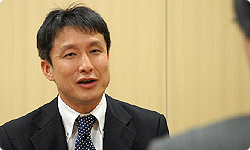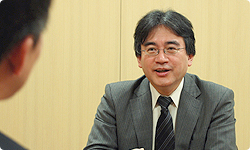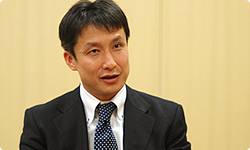1. 1000 Fewer Steps than a Decade Ago
Firstly, thank you very much for coming all the way to Kyoto today.
It’s my pleasure.
I should explain that Dr Miyachi of the National Institute of Health and Nutrition1 was kind enough to act as an adviser for Wii Fit Plus. 1 The National Institute of Health and Nutrition was established by Japan’s Ministry of Home Affairs in 1920. It is an official body charged with improving standards of public health by conducting research and carrying out surveys concerning the health of the Japanese population, their diet and general levels of nutrition.
I was involved in the latter half of the software's development, and we actually used Wii Fit Plus in order to measure the exercise intensity2 of each training so that the users would know how many calories they’ve burned off, and we also gave a number of advices on how to combine the different trainings. 2 This refers to the ratio of heart rate calculated either during or immediately after training exercises to maximum heart rate. It is expressed as a numerical value that people can use as a way to measure their physical capabilities.
I would like to ask you to talk in detail about that a little later in the interview, if I may. To start with, can I ask you what kind of research you have carried out up to now and how you ended up doing your current research?
Okay. Well, I graduated from the National Institute of Fitness and Sport in Kanoya3, the only national university specialising in physical education. When I was a high school student, I had wanted to be a P.E. teacher and applied for that university, which had just been founded that very year. 3 The National Institute of Fitness and Sport in Kanoya City, Kagoshima Prefecture, Japan, is a national university specialising in physical education founded in 1981.
So you were in the very first year of students.
Right, which is why the teachers were incredibly passionate and went above and beyond the call of duty in the superb level of education they gave us.
I’d say that while that level of passion in the education you were given meant you were incredibly lucky on the one hand, it probably also served to pull you in a different direction from your original dream to be a P.E. teacher! (laughs)
Yes, exactly! (laughs) I ended up having little choice but to devote myself to study. I was originally a rugby player and when I came to combine my research with rugby, I realised how interesting it was to do research into physical exercise.

Out of interest, when you were playing rugby, to what degree was your training - and the world of sports in general - scientific in nature and how much was psychologically-based training?
By which you mean...? (laughs)
Well, when I was a high school student, there was a period when I was actually a committed member of the volleyball team. School sports clubs at that time were basically focussed on showing grit and determination.
So you wouldn’t be allowed to drink water while you were training, for instance?
Right, that’s exactly what it was like! (laughs)
Yes, that's how things used to be. But then so-called sports science became an essential part of sports clubs from the 1980s, right around the time that we were starting university.
I see.
I think that was probably a positive thing for me. After entering university, I had opportunities to experience training based on scientific research, so I was able to see how the exercise I was doing was scientific and theoretically-grounded. Then while I was gaining more experiences of this nature, I went on to do a Master’s Degree and began to study what kind of changes people’s bodies went through during physical training. When I finished the Master’s Degree, I went to Kawasaki University of Medical Welfare4 in Okayama Prefecture. It was originally the Kawasaki Medical University and focussed on medicine, but a Health and Physical Education Department had just been set up and again I found myself among the first year of students there… 4 Kawasaki University of Medical Welfare is a private health and welfare university which has its main facility in Kurashiki City in Okayama Prefecture, Japan. It was established in 1991.
You seem to have a knack for that! (laughs)
Yes, I do! (laughs) But by this point I had also started to lecture...
And how many years did you spend at that university?
I was there for fourteen years. During that time, I worked to gain a post as a lecturer while also carrying out my own research. Then six years ago, I began working for the National Institute of Health and Nutrition in Tokyo.
Could you explain briefly what kind of organisation the National Institute of Health and Nutrition is?
It’s a research facility under the auspices of the Ministry of Health, Labour and Welfare. It does research in order to improve the general health of the nation by determining what sort of diet and exercise regime the population should be following.
And what is your particular goal in the work you do?
My role at the Institute of Health and Nutrition is to work as the project leader for the team working on devising exercise guidelines. So my goal is "to construct the guidelines for physical exercise needed to improve the health of the nation". But I’m not permitted simply to go off and do my own independent research in order to work towards that goal. I collate research from around the world and analyse it, putting it in a form that will be useful to everyone...
So your goal is to gather reports and research from around the world, while at the same time doing your own research, and then to come up with guidelines for physical exercise which can be recommended for use by anyone in Japan.

That’s right. However, as these guidelines are what you’d call a highest common denominator, it will never be something that we can recommend to absolutely everyone.
But by coming up with the guidelines, you are certainly contributing something positive to the general level of health of the nation.
Yes, that’s right.
But having said that, while every adult in Japan knows that they should be exercising, there are times when they just can’t quite manage it! (laughs)
Right, there are times when they can’t quite seem to manage it! (laughs)
Out of interest, what percentage of the Japanese population exercises on a regular basis?
Well, it’s difficult to define precisely what constitutes regular exercise, but one definition is that it should be one hour of exercise per week: in other words, approximately two half-hour exercise sessions per week. So people who work up a light sweat by exercising this much can be defined as doing regular exercise.
In which case, I qualify! That’s a relief! (laughs)
(laughs) That means that about 35-40% of the population exercise regularly. Or to put it the other way, between 60-70% of the Japanese population do not exercise on a regular basis.
I see.
There is also another way of measuring exercise that takes as its criterion the number of steps taken each day. To put it simply, it is defined by whether or not you walk 10,000 steps or more each day.
You often hear about “10,000 steps a day.”
That’s right. Anyone who walks 10,000 steps every day can be defined as being an active person. But there may not even be 20% of the population who qualify.
Anyone whose job entails walking around will be able to reach 10,000 steps a day fairly easily, but I’d say that for anyone who commutes to work and then does a desk-based job, it would be absolutely impossible to walk that much without making a deliberate effort.
You’re correct. We have actually researched the average number of steps that Japanese people are currently walking each day. It turns out that men are averaging just over 7000 steps a day, while women are averaging a little over 6000. It’s not even coming close to 10,000 steps a day. That means that Japanese people are increasingly leading sedentary lifestyles.

Would you say that, as a whole, society is moving in that direction because, while people were more active in the past, life has in a sense now become too convenient?
Yes, and I think that we saw a turning point a decade ago. At that time, men averaged 8000 steps a day, while women averaged about 7000, which means that it was a whole 1000 steps a day more than it is now.
Really?
That figure began to fall steeply ten years ago and the average number of steps taken has fallen year on year ever since. At the same time however, the number of people who are spending their free time playing tennis, going to gyms or taking regular exercise - and this includes using Wii Fit – has actually slowly increased. But the amount of exercise taken by walking around in the course of everyday life has been steadily decreasing.
Would you say that this is due to everyday life becoming more convenient and also to changes in people’s lifestyles?
One reason is the continued development we see in Information Technology.
You’re talking about people who are staring at a computer screen all day long…
You’re now able to do the shopping over the Internet without even going out to the shops. A lot of unprofitable bus routes and train lines have also been discontinued so that as you get further into the countryside, the rate of automobile ownership increases and the American-style motorisation of society becomes more pronounced. But the biggest single factor is that the number of people no longer working on Saturdays has greatly increased.
The single biggest reason is that there are fewer people working on Saturdays? That’s surprising to hear.
While it’s a good thing from the point of view of the workers, when we were younger we used to always work until 1pm on a Saturday. We’d call it a half-holiday. That’s now a thing of the past.
Saturday is generally a day off in schools now too.
That’s right. So a combination of the three factors I’ve mentioned has had an increasingly pronounced effect over the last decade and has led to the current situation.
I see. If this state of affairs is allowed to continue, there will be an increased risk of various lifestyle-related diseases...
Obesity, in particular.
So you would say that you have the sense that there is a crisis in the state of the nation’s health?
I have an extremely keen sense that we are in the midst of a crisis. That’s why my goal is not simply to put together guidelines for exercises, but to strive until the end of my life to get the Japanese people to take more exercise.
So that’s your life’s work.
Yes, it is. At the very least, that’s the major goal I’m pursuing until I reach retirement age.
